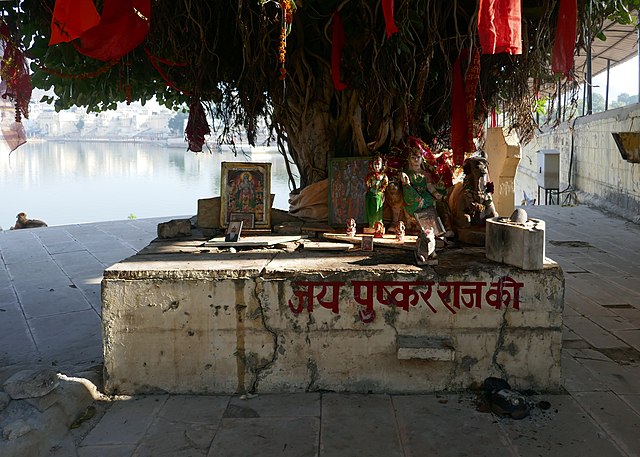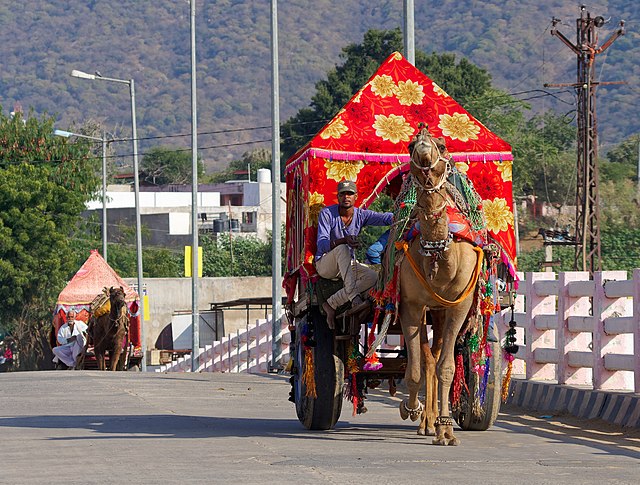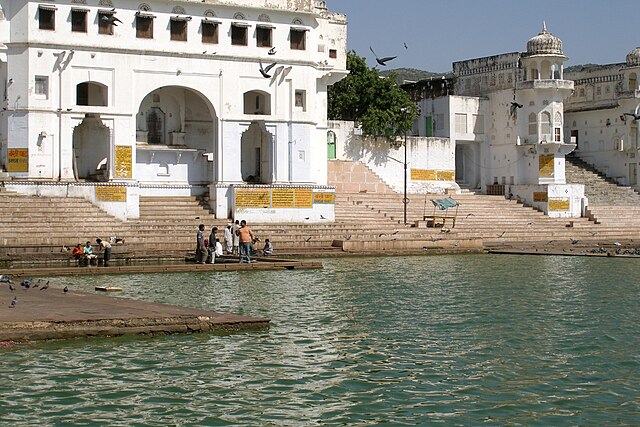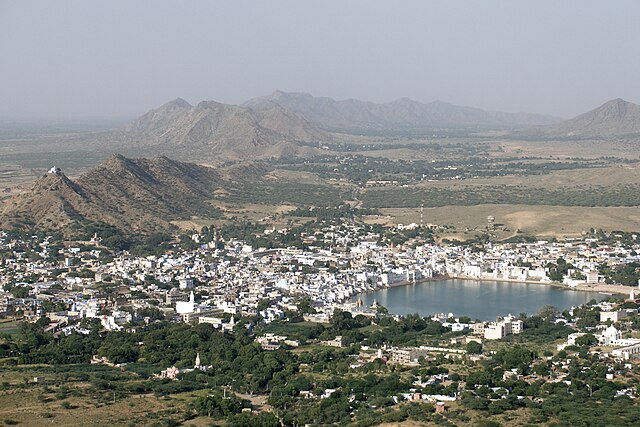Nestled in the heart of Rajasthan’s Thar Desert, Pushkar stands as one of India’s most sacred cities, drawing millions of pilgrims and travelers from around the globe. This mystical oasis, with its shimmering holy lake and ancient temples, offers an enchanting blend of spirituality, culture, and desert adventure that captivates every visitor’s heart.
Have you ever wondered what makes a small desert town so spiritually significant that it’s mentioned in ancient Hindu scriptures? Pushkar isn’t just another tourist destination – it’s a living, breathing testament to India’s rich spiritual heritage, where every grain of sand seems to whisper tales of devotion and divine intervention.
What Makes Pushkar Special?
Pushkar’s uniqueness lies in its perfect fusion of mythology, spirituality, and vibrant culture. Unlike other tourist destinations that rely solely on historical monuments or natural beauty, Pushkar offers something far more profound – a spiritual experience that touches your soul.
The city revolves around its sacred lake, believed to have been created by Lord Brahma himself. This isn’t just folklore; for devout Hindus, Pushkar represents one of the most important pilgrimage sites, where taking a dip in the holy waters is said to cleanse sins and grant salvation.
The Legend Behind the Holy Lake
According to Hindu mythology, the story of Pushkar’s creation reads like a divine fairy tale. Lord Brahma, the creator of the universe, was searching for a suitable place to perform a yajna (sacred fire ritual). As he flew across the land on his swan, a lotus flower fell from his hand. Where the lotus petals touched the earth, three lakes formed – and the largest became Pushkar Lake.
The name “Pushkar” itself derives from “pushpa” (flower) and “kar” (hand), literally meaning “from the hand of the flower.” This celestial origin story explains why the lake is considered so sacred that even a single sip of its water is believed to have purifying powers.
Spiritual Significance in Hindu Culture
In Hindu tradition, Pushkar holds the distinction of being one of the five sacred dhams (pilgrimage sites) that every devout Hindu aspires to visit. The city’s spiritual importance is amplified by the presence of over 500 temples, each telling its own story of devotion and architectural brilliance.
What sets Pushkar apart from other pilgrimage sites is its intimate atmosphere. Unlike the crowded ghats of Varanasi or the grand temples of South India, Pushkar offers a more personal spiritual experience. The relatively small size of the town means you can walk from one sacred site to another, creating a meditative journey through narrow lanes lined with colorful houses and ancient temples.
Top Attractions in Pushkar

Pushkar may be small, but it packs an incredible punch when it comes to attractions that blend spirituality with stunning architecture and natural beauty.
Pushkar Lake – The Heart of Devotion
The sacred lake serves as Pushkar’s spiritual and geographical center, surrounded by 52 ghats (stone steps leading to the water). Each ghat has its own significance and story, creating a amphitheater of devotion around the pristine waters.
Early morning at the lake presents an almost ethereal scene. As the sun rises over the Aravalli Hills, the golden light dances on the water’s surface while devotees perform their morning rituals. The sound of temple bells mingles with the gentle lapping of water against the ghats, creating a symphony of serenity that’s impossible to replicate elsewhere.
The lake’s ecosystem is carefully protected, with strict regulations ensuring no soap or pollutants enter the sacred waters. This preservation effort has maintained the lake’s clarity and spiritual purity for centuries, making it a perfect mirror for both the sky above and the souls of those who visit.
Brahma Temple – One of a Kind
Here’s something that might surprise you: despite being the creator in the Hindu trinity, Lord Brahma has very few temples dedicated to him worldwide. The Pushkar Brahma Temple is not just rare – it’s virtually unique, making it one of the most significant religious sites in Hinduism.
Built in the 14th century, the temple showcases stunning marble architecture with intricate carvings that tell stories from Hindu mythology. The temple’s distinctive red spire rises majestically against the desert sky, serving as a beacon for pilgrims from far and wide.
What makes visiting this temple truly special is the palpable sense of history and devotion that permeates every corner. The four-faced idol of Lord Brahma, adorned with fresh flowers and offerings, creates an atmosphere of divine presence that even non-believers find moving.
Savitri Temple – A Hilltop Adventure
Perched atop a hill overlooking Pushkar, the Savitri Temple offers more than just spiritual blessings – it provides breathtaking panoramic views of the entire city and surrounding desert landscape. The temple is dedicated to Goddess Savitri, Lord Brahma’s first wife, and the climb to reach it is both a physical and spiritual journey.
The trek takes about 30-45 minutes, winding through rocky paths and offering glimpses of local wildlife and desert flora. As you ascend, the city below gradually transforms into a miniature model, with the sacred lake appearing like a jewel set in the desert crown.
Gayatri Temple – The Other Side of the Story
On the opposite hill stands the Gayatri Temple, dedicated to Lord Brahma’s second wife. According to legend, Goddess Savitri cursed the location, which is why devotees often visit both temples to complete their spiritual journey and avoid any divine displeasure.
The temples on opposite hills create a symbolic representation of the complex relationships in Hindu mythology, reminding visitors that even divine stories involve human emotions and conflicts.
Pushkar Bazaar – Shopping Paradise
The vibrant Pushkar Bazaar stretches through the heart of the old city, offering an authentic Rajasthani shopping experience that’s both exciting and overwhelming. The narrow lanes burst with color, displaying everything from traditional textiles and jewelry to spiritual artifacts and modern trinkets.
What makes shopping in Pushkar special is the authenticity of the experience. Unlike commercialized tourist markets, Pushkar’s bazaar retains its traditional character, with local artisans selling handcrafted items that have been made using techniques passed down through generations.
The Famous Pushkar Camel Fair

If Pushkar is Rajasthan’s spiritual heart, then the annual Pushkar Camel Fair is its cultural soul. This extraordinary event transforms the quiet desert town into a vibrant carnival that attracts visitors from around the world.
When Does It Happen?
The Pushkar Camel Fair typically occurs in October or November, coinciding with the full moon of the Hindu month of Kartik. The exact dates vary each year according to the lunar calendar, but the fair usually lasts for five days, building up to the climax on the full moon night.
Planning your visit during the fair requires advance booking, as accommodation prices soar and availability becomes scarce. However, the experience is so unique that many travelers consider it worth the extra cost and effort.
What to Expect at the Fair
Imagine a scene straight out of an Arabian Nights tale: thousands of camels, decorated with colorful textiles and bells, creating a sea of humps across the golden desert sand. The fair begins as a traditional livestock market where rural Rajasthani traders come to buy and sell camels, horses, and cattle.
But the Pushkar Fair is far more than just an animal market. It’s a complete cultural immersion where you’ll witness traditional Rajasthani life in all its colorful glory. The fairgrounds buzz with activity from dawn to dusk, offering endless opportunities for photography, cultural exchange, and unforgettable experiences.
Cultural Performances and Competitions
The fair features a variety of competitions that showcase the skills and traditions of rural Rajasthan. Camel racing, where jockeys race across the desert sands, creates clouds of dust and tremendous excitement among spectators. The “longest mustache” competition celebrates Rajasthani pride in facial hair, while folk dance performances bring ancient stories to life through graceful movements and vibrant costumes.
Hot air balloon rides during the fair offer a bird’s-eye view of this spectacular gathering, providing photo opportunities that capture the sheer scale and beauty of this unique event.
Best Time to Visit Pushkar

Timing your visit to Pushkar can make the difference between a good trip and an unforgettable experience. The desert climate means extreme variations in temperature throughout the year, making some seasons far more comfortable than others.
Weather Throughout the Year
Pushkar experiences a typical desert climate with hot summers, mild winters, and a brief monsoon season. Summer temperatures can soar above 45°C (113°F), making outdoor exploration almost unbearable. The winter months from October to March offer the most pleasant weather, with daytime temperatures ranging from 20-30°C (68-86°F) and cool, comfortable nights.
The monsoon season (July-September) brings occasional rainfall that transforms the desert landscape into a surprisingly green oasis. While the rains cool the temperature, they can also disrupt travel plans and outdoor activities.
Festival Season vs Off-Season
Visiting during the Camel Fair means experiencing Pushkar at its most vibrant, but also at its most crowded and expensive. If you prefer a more peaceful spiritual experience, consider visiting during the shoulder seasons (September-October or March-April) when the weather is still pleasant but the crowds are thinner.
The summer months offer the lowest prices and smallest crowds, but the intense heat limits outdoor activities to early morning and late evening hours.
Where to Stay in Pushkar
Pushkar’s accommodation options reflect its dual nature as both a spiritual destination and a tourist hotspot, offering everything from luxury heritage hotels to budget backpacker hostels.
Luxury Heritage Hotels
Several former palaces and havelis have been converted into luxury hotels that offer a taste of royal Rajasthani lifestyle. These properties typically feature traditional architecture, courtyards with fountains, and rooftop restaurants with views of the lake and surrounding hills.
Staying in a heritage hotel provides more than just comfortable accommodation – it’s an immersive cultural experience where every detail, from the hand-painted walls to the traditional furniture, tells a story of Rajasthani craftsmanship and hospitality.
Budget-Friendly Options
Pushkar has a well-established backpacker scene, with numerous guesthouses and hostels offering clean, basic accommodation at very reasonable prices. Many of these budget options are located near the lake or in the old city, providing easy access to major attractions and the authentic atmosphere of traditional Pushkar life.
Unique Desert Camping Experience
For a truly memorable stay, consider spending a night or two in a desert camp outside the city. These camps offer comfortable tents with modern amenities while providing an authentic desert experience complete with camel rides, folk performances, and stargazing opportunities under the clear desert sky.
Desert camping allows you to experience the silence and vastness of the Thar Desert, creating a perfect counterpoint to the bustling activity of the city center.
Local Cuisine and Must-Try Foods
Pushkar’s culinary scene reflects its spiritual nature – the entire city is vegetarian, and many restaurants don’t serve alcohol, creating a unique dining culture focused on pure, sattvic food.
Vegetarian Delights
Don’t let the lack of meat fool you into thinking Pushkar’s cuisine is bland or limited. Rajasthani vegetarian cuisine is incredibly diverse and flavorful, using aromatic spices and creative cooking techniques to transform simple ingredients into memorable dishes.
Dal baati churma, Rajasthan’s signature dish, consists of lentil curry served with baked wheat balls and a sweet crumbled mixture. Gatte ki sabzi (gram flour dumplings in spicy curry) and ker sangri (a desert bean and berry preparation) showcase the creativity of desert cooking, where scarce ingredients are transformed into delicious meals.
Popular Restaurants and Cafes
Pushkar’s dining scene includes everything from traditional Rajasthani thalis served on banana leaves to international cafes catering to backpackers from around the world. Many restaurants feature rooftop seating with lake views, creating romantic settings for dinner as the sun sets over the sacred waters.
The fusion of traditional recipes with international presentation creates a unique dining experience where you might find pasta made with local spices or traditional sweets presented with modern flair.
How to Reach Pushkar
Despite its remote desert location, Pushkar is surprisingly accessible through multiple transportation options.
By Air, Train, and Road
The nearest airport is in Jaipur, approximately 150 kilometers away, with good connectivity to major Indian cities and some international destinations. From Jaipur, you can hire a taxi or take a bus to reach Pushkar in about 3 hours.
Ajmer, just 11 kilometers from Pushkar, has a major railway station with trains connecting to Delhi, Mumbai, Jaipur, and other important cities. From Ajmer, local buses, taxis, and auto-rickshaws provide easy access to Pushkar.
Road connectivity is excellent, with regular bus services from major Rajasthani cities and well-maintained highways that make self-driving a viable option for those who prefer independence and flexibility.
Transportation Within the City
Pushkar’s compact size makes it perfect for walking, and most major attractions are within easy walking distance of each other. The narrow lanes of the old city are often too small for cars, making walking not just practical but necessary.
For longer distances or visits to hilltop temples, auto-rickshaws and cycle-rickshaws are readily available. Many visitors enjoy renting bicycles to explore the surrounding countryside and get a different perspective on the desert landscape.
Things to Do in Pushkar
Beyond temple visits and spiritual activities, Pushkar offers a surprising variety of experiences that cater to different interests and energy levels.
Spiritual Activities
Participating in the evening aarti (prayer ceremony) at Pushkar Lake creates an unforgettable spiritual experience. As hundreds of oil lamps float on the sacred waters and devotees chant prayers, the entire lake transforms into a sea of light that reflects both in the water and in the hearts of those present.
Meditation and yoga sessions, offered by various centers around the city, provide opportunities to deepen your spiritual practice in one of India’s most sacred environments. Many visitors find that the peaceful atmosphere of Pushkar naturally encourages introspection and spiritual growth.
Adventure and Recreation
The desert location provides excellent opportunities for adventure activities that add excitement to your spiritual journey.
Desert Safari and Hot Air Ballooning
Camel safaris into the surrounding Thar Desert offer chances to experience the vast silence and beauty of the desert landscape. These excursions can range from short sunset rides to multi-day camping adventures that take you deep into the desert.
Hot air ballooning over Pushkar provides breathtaking aerial views of the city, lake, and surrounding desert. The early morning flights offer perfect lighting conditions for photography and a unique perspective on this sacred landscape.
Shopping in Pushkar
Shopping in Pushkar combines the thrill of discovery with the satisfaction of supporting local artisans and traditional crafts.
What to Buy
Pushkar’s markets specialize in authentic Rajasthani handicrafts, textiles, and jewelry. Bandhani (tie-dye) fabrics, mirror-work textiles, and traditional Rajasthani clothing make popular souvenirs that capture the colorful spirit of the region.
Silver jewelry, particularly pieces featuring traditional Rajasthani designs, offers excellent value and authentic craftsmanship. Camel leather products, from bags to shoes, provide practical souvenirs that remind you of Pushkar’s desert heritage long after you return home.
Bargaining Tips
Shopping in Pushkar requires patience and good humor, as bargaining is not just expected but part of the cultural experience. Start by offering about 30-40% of the quoted price and gradually work toward a mutually acceptable amount.
Building rapport with shopkeepers often leads to better prices and genuine recommendations for other purchases. Remember that your bargaining should be friendly and respectful – after all, you’re participating in a cultural tradition that’s been practiced for centuries.
Cultural Etiquette and Tips
Visiting Pushkar requires sensitivity to local customs and religious practices that have been maintained for generations.
Dress modestly, especially when visiting temples or the lake area. Remove shoes before entering temples and avoid wearing leather items, as many temples have strict rules about animal products. Photography inside temples is often prohibited, so always ask permission before taking pictures.
Respect the sacred nature of the lake by avoiding swimming or using soap in the water. Many ghats have specific protocols for ritual bathing, so observe local practices and ask for guidance if you’re unsure about appropriate behavior.
The city’s vegetarian culture should be respected throughout your stay. Even if you’re not vegetarian, embracing the local food culture creates opportunities to discover new flavors and shows respect for local beliefs.
Conclusion
Pushkar stands as a testament to India’s incredible ability to blend the spiritual with the spectacular, creating a destination that touches hearts while dazzling the senses. Whether you come seeking spiritual enlightenment, cultural immersion, or simply a unique travel experience, this sacred oasis in the Thar Desert delivers on all fronts.
The city’s compact size belies its tremendous impact on visitors, who often find themselves returning year after year, drawn by an indefinable magic that combines ancient wisdom with vibrant contemporary culture. From the early morning prayers at the sacred lake to the colorful chaos of the bazaar, from the serene hilltop temples to the excitement of the camel fair, Pushkar offers experiences that linger in memory long after the desert dust has been washed from your clothes.
As you plan your journey to this remarkable destination, remember that Pushkar is more than just another stop on the tourist trail – it’s an opportunity to connect with something timeless and profound in one of the world’s most spiritually significant locations.
Frequently Asked Questions
1. Is Pushkar safe for solo female travelers?
Yes, Pushkar is generally considered very safe for solo female travelers. The spiritual nature of the city creates a respectful atmosphere, and the large number of international visitors means locals are accustomed to diverse travelers. However, basic precautions like dressing modestly and avoiding isolated areas at night are always recommended.
2. How many days are needed to fully explore Pushkar?
Most visitors find 2-3 days sufficient to explore Pushkar’s main attractions and soak in the spiritual atmosphere. However, if you’re visiting during the Camel Fair or want to include desert camping and adventure activities, 4-5 days would be ideal.
3. Can non-Hindus participate in religious ceremonies at Pushkar?
While non-Hindus are welcome to observe most ceremonies respectfully, active participation may be limited to certain rituals. It’s best to ask local priests or guides about appropriate ways to show respect without inadvertently violating religious protocols.
4. What should I pack for a trip to Pushkar?
Pack light, comfortable cotton clothing, a hat and sunscreen for desert sun protection, comfortable walking shoes, and modest attire for temple visits. If visiting in winter, bring warm layers for cool evenings. Don’t forget a good camera to capture the incredible scenery and cultural experiences.
5. Are there any restrictions on photography in Pushkar?
Photography is generally allowed in most public areas, but many temples prohibit cameras inside. The lake area and ghats are usually fine for photography, but always be respectful of people performing religious rituals and ask permission before photographing individuals, especially during prayers or ceremonies.

